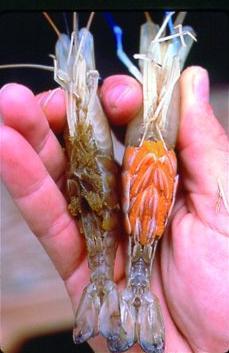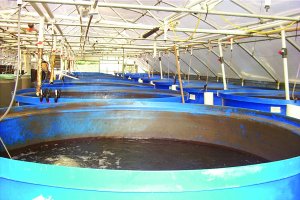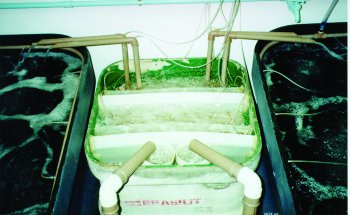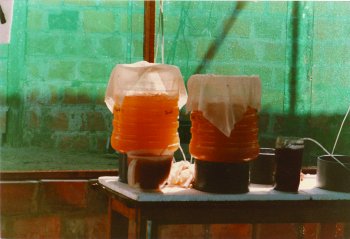|
Hatchery Management
Selection and Transporation of Broodstock
In the wild, berried females are most abundant around the beginning of the rainy
season. When M. rosenbergii is reared in areas where the climate is sub-tropical
or temperate, broodstock are typically obtained from ponds during the harvest at
the end of the growing season and maintained indoors in environmentally controlled
conditions during winter.
Broodstock constitutes an essential component in the hatchery phase. Freshwater
ponds are required for the development of broodstock to have an uninterrupted supply
of berried prawns to the hatchery. The advanced juveniles (>5 g) are stocked
@ 1-2/m2 at a male female ratio of 1:4 in well-prepared earthen ponds.
The prawns are fed with specially formulated broodstock diet (crude protein - 38%,
lipid - 8%) twice daily @ 10% of the biomass for the first two months and subsequently
at rates ranging from 5-2% of the biomass. The ponds are monitored and managed on
a regular basis to maintain optimum water quality.
The prawns attain maturity in 2-3 months and females bearing advanced embryos are
collected from these ponds regularly for the seed production purpose. This species
breeds throughout the year under optimum climatic conditions (28-32ºC). However,
in many parts of the country the peak breeding activity occurs during monsoon season,
i.e. from July to November. For the operation of hatchery the berried prawns (bearing
grey embryos) are collected at regular intervals from the broodstock ponds.

Egg bearing (Berried) Females
The grey egg bearing females are collected using a cast net and are disinfected
with 0.3 ppm of copper sulphate and released for hatching in brackishwater of 5‰.
Normally average hatching fecundity is observed to be about 500 larvae per gram
body weight of berried prawn. Hatching is completed within 2-3 days, if advanced
berried prawns are collected with grey eggs on their pleopods. When hatchery do
not have the provision of ponds, then grey berried females can be collected from
either rivers or from grow-out ponds and can be kept for hatching in the larval
rearing tanks itself. If it is not possible to get adequate numbers of berried females
from nearby sources, then adult male and female prawns (>50 g) need to be stocked
in broodstock tanks at 1:4 @ 1/m2 for breeding purpose.
The prawns should be fed with brood stock diet @ 5% of the biomass daily. Cleaning
and water exchange @ 25-30% should be done daily. Berried females should be carefully
selected. Choose animals that are obviously healthy and active, well pigmented,
with no missing appendages or other damage, and carrying large egg masses. The ripeness
of the eggs is also important. As the eggs ripen, their colour changes from bright
orange to brown and finally to greyish-brown a few days before hatching. Those carrying
brown to grey eggs are the best ones to bring into the hatchery, as their eggs will
hatch within 2 or 3 days. It is best to ensure that you do this so that the whole
larval batch is of a similar age. This will increase the efficiency of your feeding
operations and reduce cannibalism. The number of females required depends on the
volume of the hatchery tank to be stocked with larvae, and on the number of eggs
carried by each female.
Transportation of the berried prawns to long distance is a hectic process. The prawns
are held in tanks or double plastic bags, the rostrum of each animal is blunted
with scissors or inserted into a plastic tube to prevent the bags being punctured.
In addition, it is recommended that you shade the animals from light during transport;
UV light may harm the eggs. Tying the chelipeds with rubber bands or covering them
with plastic tubing also reduces the danger of the plastic bags being punctured.
A nutritionally complete diet is essential to promote superior egg production and
quality. Commercially pelleted grow-out feeds can be used but need supplementation.
Broodstock should be fed at a daily rate of 1-3% of total biomass, adjusted to match
consumption. Half of the pelleted ration should be substituted with the equivalent
amount of pieces of squid (or similar fresh feeds, such as clam meat), cut to the
appropriate size, at least twice per week. 1 kg of a wet feed is roughly equivalent
to 200 g of pelleted diet. The daily food ration should be given in two equal portions,
normally in the early morning and late afternoon.
Hatchery phase
There are two basic types of nursery systems for freshwater prawns. The first type
is known as the Flow-through system, which is effectively used in many parts of
the world. The second type is the Recirculating system, which involves the use of
biological filtration to conserve water and energy usage, reduce the demand for
seawater or brine, and facilitate the establishment of inland hatcheries. They range
from simple systems utilizable by small hatcheries to sophisticated systems used
for research work and commercial hatcheries. The second type of hatchery described
in this section uses a specific form of water recirculation and is known as the
dynamic closed system. This is based on continuous circulation of the larval water
through physical and biological filters to remove solid and nitrogenous wastes.
This system can have individual biofilters for each larval tank or a common biofilter
serving several larval tanks. The latter is naturally more risky because a failure
in the system may affect a large number of larvae. However, the risk has to be balanced
against the capital and maintenance costs of multiple filtration systems.

Hatchery tanks

Biofilter for hatchery tanks
Hatchery Management
Each cycle of operations in a freshwater prawn hatchery takes up to 40 days, including
the time necessary to prepare for the next cycle. Careful attention to all aspects
of hatchery management is essential to achieve success Water needs to be treated
before it can be used in the hatchery. Usually, it is necessary to pass incoming
water through some form of physical (gravel/sand bed) filter. B erried females are
held in slightly brackishwater (~5 ppt) at 25-30°C and preferably at pH 7.0-7.2
until the eggs hatch. Temperatures below 25°C promote fungal growth on the eggs.
Temperatures below the optimum also cause some eggs to drop and increase the time
for egg development. Temperatures above 30°C encourage the development of protozoa
and other undesirable microorganisms. Light does not seem to affect egg hatchability,
although direct sunlight should be avoided.
About 1000 larvae are produced from each 1g of berried female weight. Berried females
of 10-12 cm normally carry about 10000-30000 eggs. However, many eggs are lost through
physical damage and cannibalism by the adult females during their transport from
rearing ponds or capture fisheries, and some fail to hatch. A wide variety of feeds
are employed by different hatcheries, including the nauplii of brine shrimp ( Artemia
spp.), a freshwater cladoceran ( Moina spp.), fish eggs, squid flesh,
frozen adult Artemia , flaked adult Artemia , fish flesh, egg
custard, and commercial feeds.
Most freshwater prawn larvae do not feed on the first day (hatching day). However,
it is recommended to provide some Artemia in the late afternoon of the
first day because some larvae begin to eat early. From day 2 until day 4, feed Artemia
five times per day, with the last and main feed in the evening. After that,
you can gradually reduce the number of Artemia feeds per day until, by
day 10, you are only giving Artemia at the evening feeding time. The evening
meal should be given as late as possible (18.00-19.00). The amount of Artemia
you give at each feeding time depends on your visual examination of the larval
water. Freshwater prawn larvae do not actively search for food, which is why Artemia
(which swim actively in the same part of the water column as the larvae) are
such a valuable feed type.

Ingredients for farm made larval diet
|
Ingredients
|
Larval Feed
|
|
Fish Meal
|
100 g
|
|
Skimmed milk
|
250 g
|
|
Whole egg
|
10 eggs
|
|
Freshwater
|
250 ml
|
|
Wheat flour
|
250g
|
|
Vitamin C
|
5 tablets
|
|
Vitamin A & D
|
50 drops
|
|
Vitamin B Complex
|
5 tablets
|
|
Tetracycline
|
5 capsules
|
|
Calcicol
|
10 ml
|
(Source: Food and Agriculture Organisation, 2002)
Hatchery feeding schedule
for freshwater prawn
|
Larval Stages
|
Time
|
|
07.00
|
10.00
|
11.00
|
13.00
|
16.00
|
|
I to IV
|
BSN
|
-
|
BSN
|
-
|
BSN
|
|
V
|
BSN
|
-
|
ID/EC
|
-
|
BSN
|
|
VI to PL
|
ID/EC
|
ID/EC
|
|
ID/EC
|
BSN
|
BSN = Brine Shrimp Nauplii, ID = Inert Diet, EC = Egg Custard based diet
(Source: Food and Agriculture Organisation, 2002)
There should be about 3-6 Artemia/ml directly after feeding, depending
on the age of the prawn larvae, and 1 Artemia/ml left in the water just
before the next feeding time. A density of 3-6 Artemia/ml in a tank with
5 m 3 of water means that 15 to 30 million Artemia have to be added. As
a rough guide, however, you can assume that 75 to 150 g of Artemia cysts
will be required to produce the 15 to 30 million Artemia nauplii required
for the daily feeding of a 5 m 3 larval tank initially stocked with 50 larvae/l
and expected to provide about 25 PL/l. Normally one larval cycle in this size of
tank will consume 1.25-2.5 kg of brine shrimp eggs.
Good hygiene is essential for hatchery success. Ideally, the same equipment should
not be used for more than one tank. Thus each tank would have its own dedicated
nets, siphon tubes, spare filters, etc. Water should never be transferred from one
larval tank to another. Submersible pumps, which are often used for water transfer
in hatcheries, should never be placed in the larval tanks because they are a potential
source of disease transfer. Always drain your larval tanks by gravity or siphon
and only use submersible pumps in water storage or mixing tanks. Disinfect all mobile
equipment (buckets, siphoning tubes, nets, beakers, pipettes, etc.) on a daily basis.
Dip them in a 500-ppm active chlorine solution, rinsing them very thoroughly with
water and storing them dry. Between larval rearing cycles, routinely disinfect the
larval tanks. Failure to do this usually results in massive blooms of organisms,
such as Zoothamnium , Epistylis , hydroids, etc., which are harmful
to the larvae.
Ozonisation or UV light can be employed to avoid the use of either chlorine or thiosulphate
but, of course, these add to the capital costs and have not yet been noted in commercial
freshwater prawn hatcheries. Several diseases affect freshwater prawn larvae.
An important disease in M. rosenbergii hatcheries, whose exact cause is
unknown, is referred to as the ‘mid-cycle disease' (MCD). It is most noticeable
in the middle of the larval rearing period (days 15-22 when the larvae are at stage
VI-VII), when heavy daily mortalities may occur. Mortalities may even start to become
obvious as early as day 10. The disease is recognisable by the larvae becoming bluish-grey
and swimming slowly in a spiraling pattern, as well as by a reduced rate of consumption
of Artemia and poor growth rate. Incidence of this disease can be reduced
by cleaning, disinfecting and drying out hatchery equipment between cycles and taking
special care in general hygiene throughout the larval cycle. If there is a severe
outbreak of this disease, a full clean-up of the hatchery should be considered.
Another disease, which has mainly been noted to affect larvae, is known sometimes
as the ‘exuvia entrapment disease' (EED) or as the ‘moult-death syndrome'
(MDS) or as the ‘metamorphosis moult mortality syndrome'. The characteristic
of this disease is that the larvae get trapped in the old exoskeleton (exuvia) during
moulting. It is mostly noticed towards the end of the larval rearing cycle, especially
at the moult, which occurs when, stage XI metamorphoses into the PL stage. The mortality
rate at this point can be very high. The cause of EED is not known; it may have
multiple causes. It may imply that the diet is nutritionally inadequate and requires
enrichment. Difficulties in shedding the old exoskeleton during moulting have also
been observed in juvenile and adult prawns.
Top
|